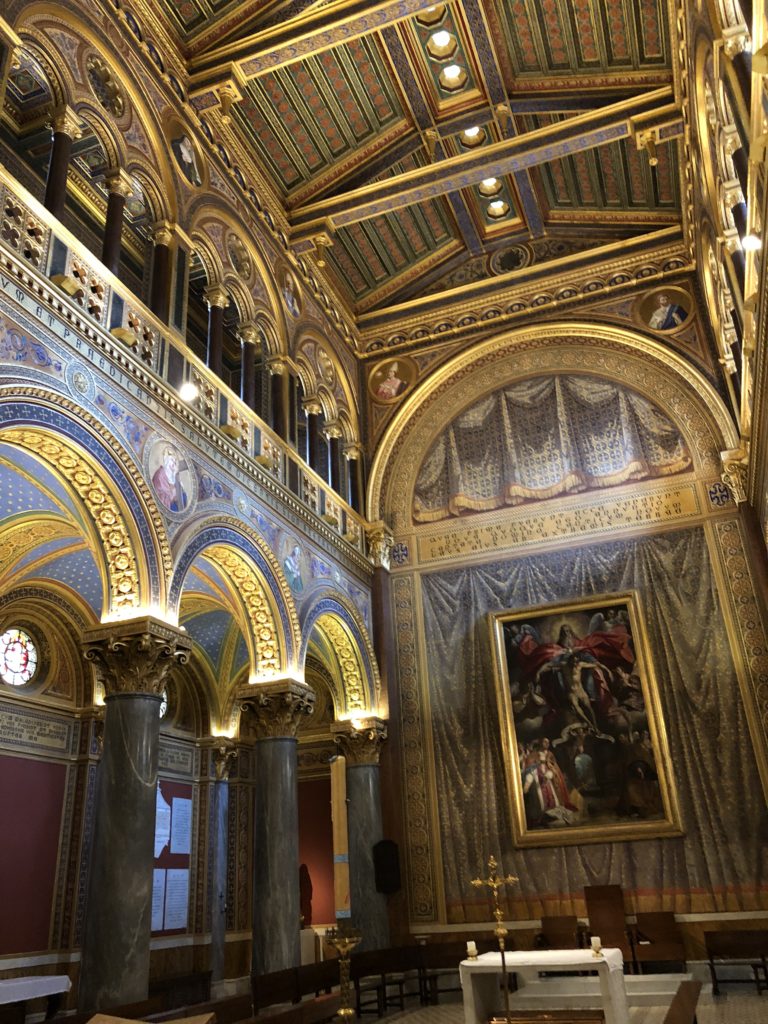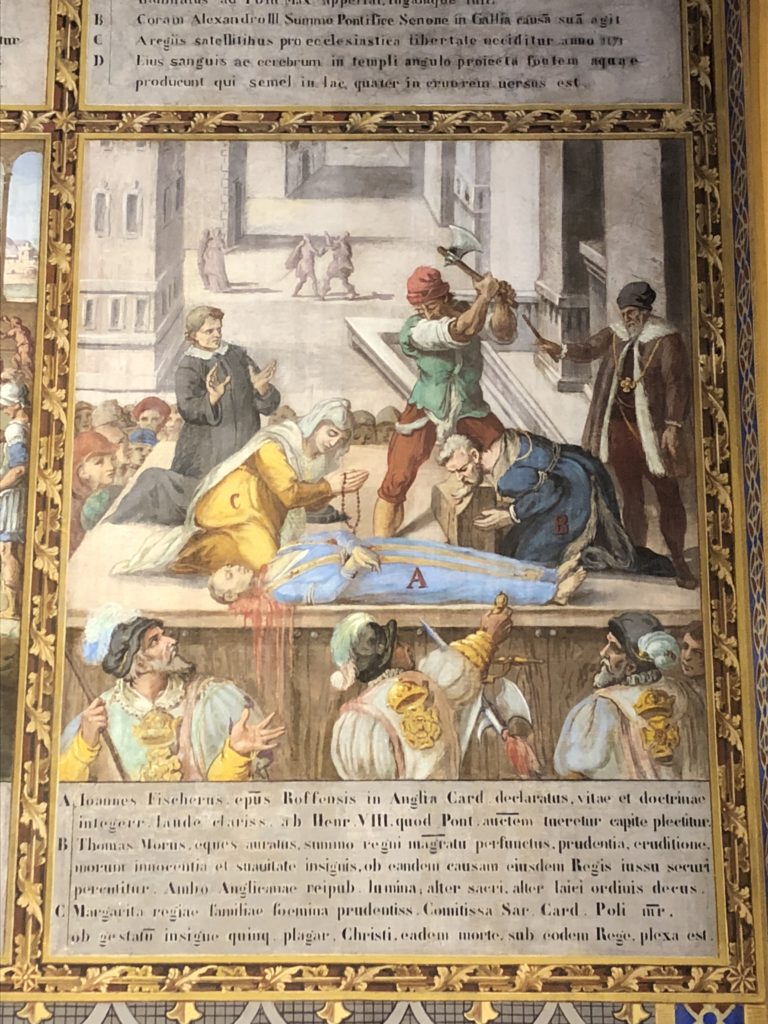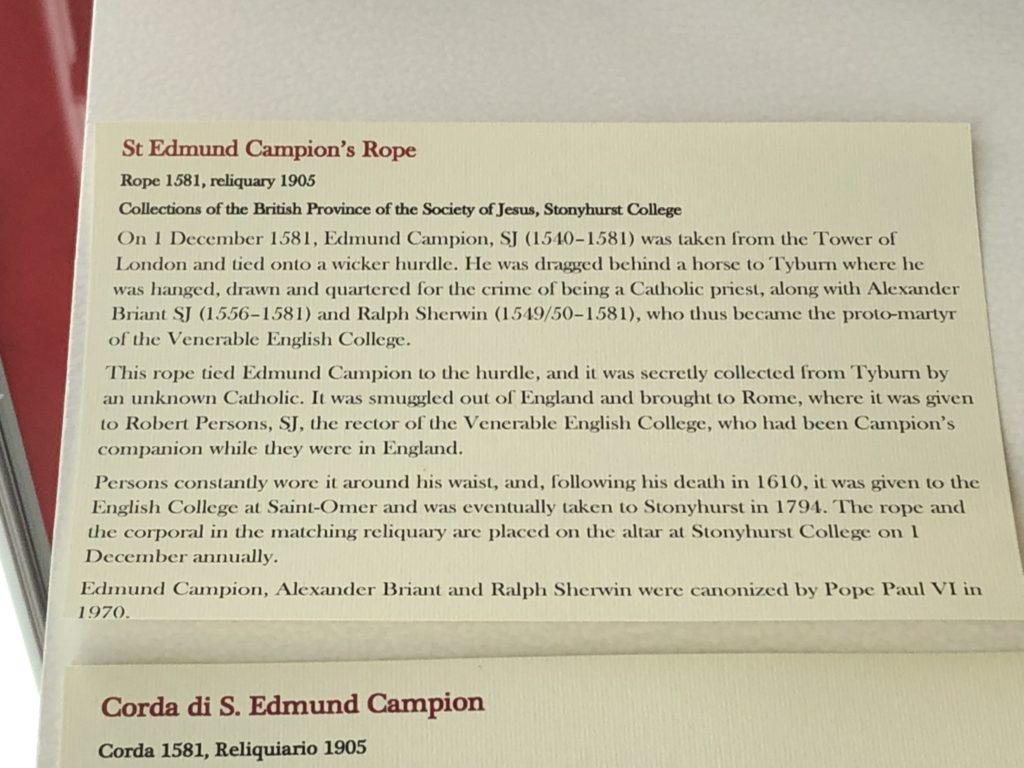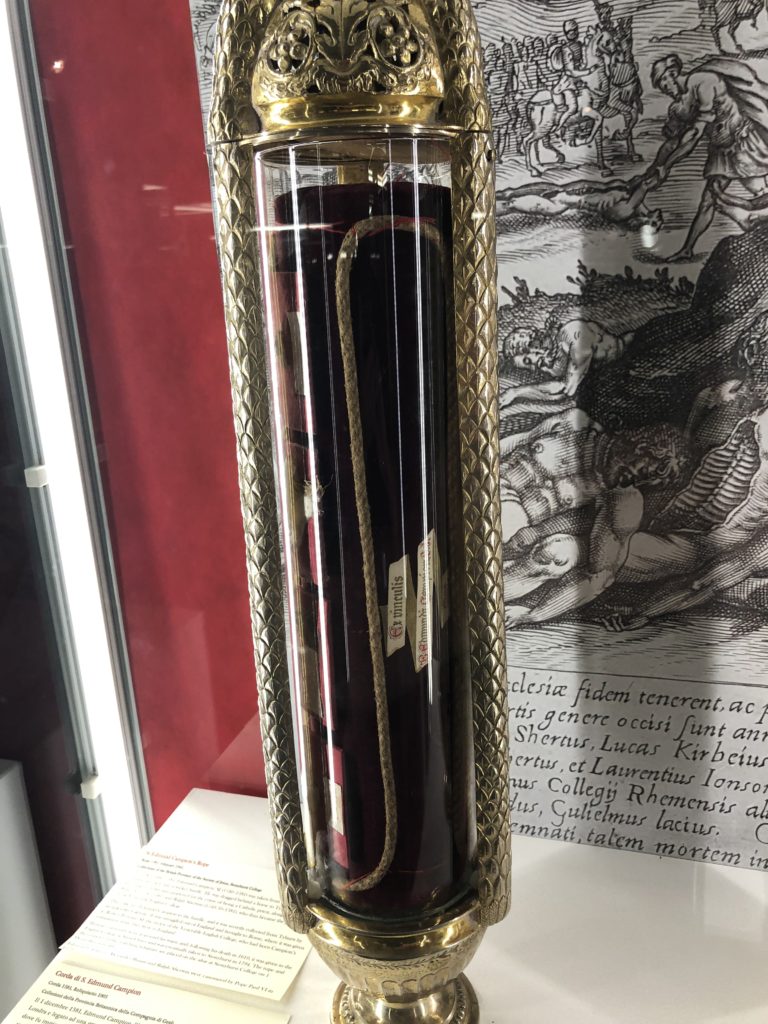Today is the Feast of the Forty Martyrs of England and Wales. There are, however, I believe really 284 beatified and canonized martyrs from the time of the Reformation in England.
The monstrous Henry VIII began to execute those who would not sign on to the Act of Supremacy, passed by Parliament in 1534 and which claimed that the King and his issue were “the only supreme head on Earth of the Church of England”, thus usurping the place of the Vicar of Christ, the Pope. Clement VII had refused to grant an annulment to Henry who wanted to put aside his duly married wife Catherine of Aragon. After the Act of Supremacy, Parliament passed the Treason Act. Anyone refusing to sign on to the Act of Supremacy was therefore deemed to have committed treason, a capital crime. Sts. Thomas More and John Fisher were the most famous of those slain by refusing to go along. There was another Act of Supremacy passed in 1558 under Elizabeth because the Catholic Queen Mary had had the previous Act repealed in 1554. This would lead eventually to the virtual conflation of Church and State which has remained as a powerful corrosive force in the Anglican “Church” of England to this day. Effectively, as societal mores change, because of politics the doctrine of its “Church” must change.
At the time of Elizabeth, Pope St. Pius V in 1570 excommunicated the Queen and released all her subjects from obedience to her. In turn she enacted harsher laws, making it high treason for any priest to be in England and for any person to aid them. The usual punishment was to hang, draw and quarter then, many at Tyburn which is now at a traffic crossing in London near Marble Arch at the intersection of Edgeware and Oxford Street.
In 1896 Leo XIII declared in his Bull Apostolicae curae that Anglican orders were “absolutely null and void”. In 2000 the CDF clarified in Dominus Iesus that bodies without apostolic succession are not, technically, true churches, and refers to them as “ecclesial communities”.
Once upon a time, the Feast of the Forty Martyrs was celebrated on 25, which is the Feast of Sts. Crispin and Crispinian, whose relics are in San Lorenzo in Panisperna in Rome.
Speaking of Rome, the residence of English seminarians the priests studying in the Eternal City, the English College not far from the Palazzo Farnese on the Via di Monserrato. The chapel of the College has murals of the English Martyrs, some of whom had studied in Rome in that very place.


In May of 2018, I went to the English College for a spectacular exposition of items from the time of the English martyrs. For example:


Alumni of the English College have reason to be proud of their fellows. My good friend Fr. Timothy Finigan has posted a video about the English Martyrs and I refer you to his fine blog. HERE
Let us not forget that there are modern martyrs. The number of martyrs in the 20th century is truly staggering. There are our suffering brethren in China, now in an ever worsening position because of the “deal” made with the Holy See. There are signs of rising persecution within and without.
Ask the holy martyrs of every age to help us in our times.


































The current Liturgical Calendar for England and Wales has this day as the Feast of the English Martyrs, encompassing all those canonised and beatified martyrs who witnessed to the Catholic Faith between 1535 and 1608. May 4th 1535 saw the execution of three Carthusians, St John Houghton, prior of the London house, St Robert Lawrence and St Augustine Webster, respectively priors of Beauvale and Axholme, together with St Richard Reynolds from Syon Abbey and the parish priest of Isleworth, Blessed John Hailes.
Correction: 1680, not 1608.
Prostitant agitprop would have us believe that Jamestown was a purely Prostitant enterprise….but of course no. As excavations have progressed, now reaching the earliest days of the settlement, the archaeologists have found rosaries and even a reliquary. There were recusants there….fleeing persecution at home.
Those with brains to think….let them think! England was the most Catholic realm in Europe before a syphilis-ridden maniac went on his tear. Entire monasteries that did nothing but pray for the dead….all ripped from the soil of their homeland on the whim of a lunatic. It is all such an infernal pity, this pointless rending of Christian unity.
Five hundred years on….is Heaven finally fed up?
Margaret Clitherow is my confirmation patron.
Thank you, Father, for this remembrance of the English Martyrs and the photo and information on the relic of St. Edmund. Wow. He truly suffered. Could I do the same? I only pray that I could. What a glorious crown he must have!
Thanks for the link to Fr. Finigan’s excellent video too.
St. Edmund Campion, and all holy martyrs, pray for us!
” syphilis-ridden maniac went on his tear”
There is no evidence I know of that confirms Henry was a syphilitic.
That would give him a way out, he was mad.
Oh no, Henry Tudor, wasn’t mad, he was bad to the bone, he murdered those he merely didn’t like anymore ie the Bullen woman, & anybody who opposed his political agenda ie St John Fisher, & anybody he wanted something from, ie Wolsey’s Hampton Court Palace.
He despoiled the Church, & he murdered casually, Good King Hal indeed!
Pingback: 4 May: Feast of the Forty Martyrs of England and Wales | Catholicism Pure & Simple
What is ironic is that Henry VIII was initially so devout that he was given the title “Defender of the Faith” by the Pope and that title for the Monarch has persisted to this day, at least coins from my last visit to the UK in 2007 still bear “F.D” from the Latin version of this title as one of the inscriptions around the depiction of the Queen. (They used to also have Emperor (or Empress) of India but dropped that after Indian independence in 1947). I suppose they attribute a new meaning to the title since the Monarch could hardly be considered a defender of the Catholic faith as per its original intent, given that the Monarch is not even allowed to be Catholic.
Our coins are indeed still engraved with D G REG F D (Dei gratia Regina, fidei defensor* – by the grace of God, Queen and defender of the Faith). Now considered to refer to the monarch’s role as head of the Church of England rather than the original meaning as defender of the Catholic faith, of course.
But then “Catholic” itself has a curious meaning in England. The C of E is literally a broad church; it encompasses Anglo-Catholics who would be astonished to be referred to as “Protestant”, and indeed the monarch could be Catholic in that sense – what she could not be is Roman, Papist, etc., the troublesome issue being the one of supremacy that Fr Z describes. Hence in England you will often be called a “Roman Catholic” (sometimes with a pointed emphasis on the first word, which is not something I’ve heard elsewhere).
Yet English Catholics (the real ones, I mean) are often fairly well-disposed towards Her Majesty, and TLM parishes at least will often sing the Prayer for the Queen at the end of Sunday Mass (Domine, salvam fac reginam nostram…).
*arguably “defensatrix”
The title was reconferred on the English Monarch by Parliament in 1544, having been revoked by Pope Paul III when he excommunicated Henry VIII, so it is now a Protestant title.
I love novels about this era. Treason by Dena Hunt is great for feel of what it was like to live then. Also the great Robert Hugh Benson wrote Come Rack!, Come Rope! in a more Elizabethan style. Evelyn Waugh’s book on Edmund Campion is also a must read (a biography, however).
Ignatius Press also has many novelizations of lives of saints and martyrs for young adults, but they read perfectly well for all of us. Like the one on the North American Martyrs, where else to get the politically incorrect truths that can show our true Catholic history.
Belloc’s Characters of the English Reformation, and some of his other works, are also good for getting a sense of what the whole tragedy was about. (Hint: money was more important to many of the protagonists than doctrine. In particular, keeping the money and land they’d stolen from the monasteries.)
One thing he points out, which a lot of people forget, is that Elizabeth Boleyn (aka Elizabeth I) was, by the standards of the time, an illegitimate child, and therefore not the rightful heir to the throne. (Mary Stuart, Queen of Scots, was the true heir.) This explains some of the savagery of the Elizabethan persecution of Christ’s religion, and also why she threw her weight behind the brand new made-up one, despite having Catholic inclinations herself.
When I converted, I had to re-assess much of my country’s history (c. 1530-1830), and accept the fact that far from being blessed by God with prosperity, freedom, etc, we were some of the most monstrous persecutors of Christ. The catastrophe of the Reformation-Enlightenment — one movement, and a cause of the present day nihilism — would have been avoided if Henry and Miss Boleyn had stayed in Christ’s Church.
Pingback: CatholicSaints.Info » Blog Archive » Forty Martyrs of England and Wales
Our Lady of Fatima told little Jacinta that “sins of the flesh” are the sins that lead most souls to Hell.
That shocked many people when it was first revealed, and yet with a longer look one can understand the truth behind Our Lady’s words and how they can become the catalyst for many other grave sins.
Certainly this appears to be the case with Henry VIII. His fall into an ongoing adulterous relationship with Anne Boleyn (and later other women) led him into a persistent embracing of all the other seven deadly sins in consequence. It also brought terrible suffering to the Catholics in his realm for the following three centuries. The true number of martyrs in the British Isles (including Ireland) is vastly superior to the official one according to historians.
Even now, thanks to Henry VIII’s long ago sinful choices, England has grown into a pretty secular country. Henry was the wicked Pied Piper who led many of England’s Catholic “children” over the cliff to their destruction.